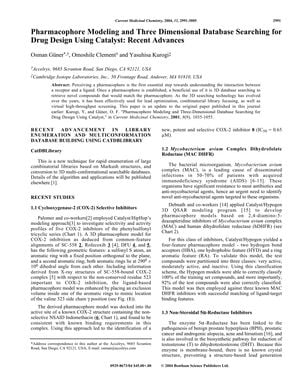Pharmacophore Modeling and Three Dimensional Database Searching for Drug Design Using Catalyst: Recent Advances
November 2004
in “
Current Medicinal Chemistry
”

TLDR The document concludes that Catalyst software is effective for drug design, identifying potent compounds for various medical conditions.
The document from 2004 highlights the use of Catalyst software in pharmacophore modeling and 3D database searching for drug design, showcasing several studies that demonstrate its effectiveness. One study identified a potent COX-2 inhibitor with an IC50 of 0.65 μM, while another developed a model for Mycobacterium avium complex dihydrofolate reductase inhibitors with high classification accuracy. A model for non-steroidal 5α-Reductase inhibitors, relevant for conditions like benign prostate hyperplasia and androgenic alopecia, identified 37 promising compounds. The document also details the creation of a pharmacophore model for serotonin reuptake inhibitors with a high correlation coefficient of 0.921 and the ability to differentiate between enantiomers of citralopram. Additionally, a model for adrenergic receptor antagonists was developed with a correlation coefficient of 0.92. The importance of CYP17 inhibitors for prostate cancer treatment is discussed, with new potent compounds identified through pharmacophore modeling. The document also mentions the search for dual inhibitors for Alzheimer's Disease and potent inhibitors for integrin VLA-4, with the most potent having an IC50 of 1.3 nM, as well as patents for selective serotonin re-uptake inhibitors with minimal CYP2D6 inhibition.





